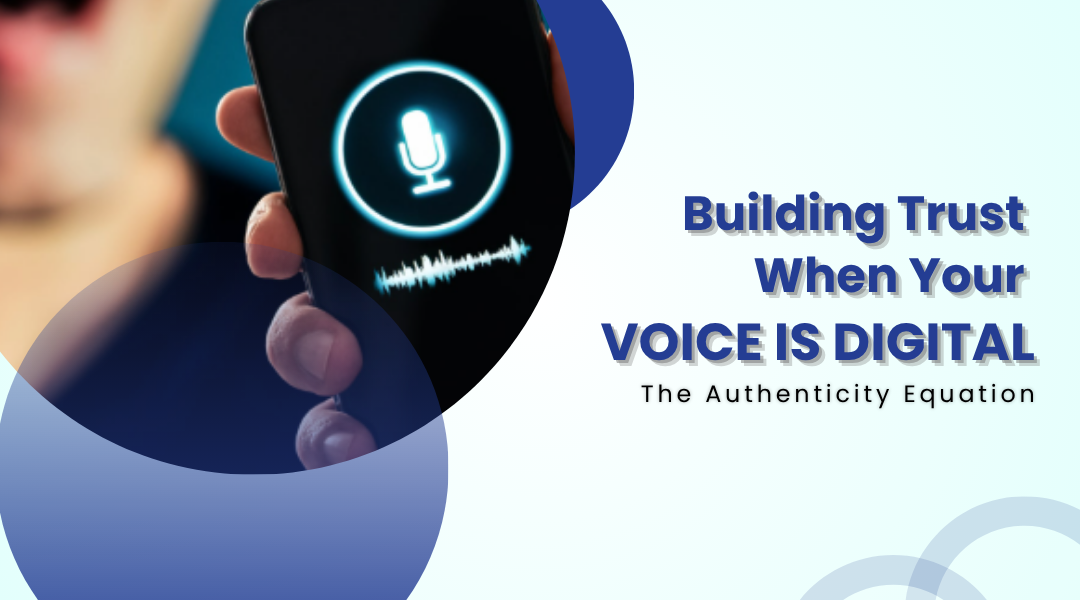In an increasingly synthetic audio landscape, a new question emerges from audiences: “Can I trust what I’m hearing?” This isn’t just about technological capability anymore—it’s about human connection. The most sophisticated voice clone means nothing if listeners feel deceived or disconnected. Building trust with a synthetic voice requires more than technical excellence; it demands emotional intelligence and strategic transparency.
The creators who will thrive in this new era understand that trust isn’t built through perfection, but through authenticity. It’s not about hiding the technology, but about integrating it so seamlessly that it enhances rather than replaces the human connection at the core of your work.
The Transparency Principle: Honesty as Your Foundation
Transparency isn’t a disclaimer—it’s an invitation into your creative process. When audiences understand why and how you’re using voice technology, they’re more likely to embrace it as an innovative tool rather than view it as a deceptive shortcut.
Effective Transparency Practices:
- Contextual Disclosure: Rather than burying a generic AI notice in your description, weave the information naturally into your content. A simple “I’m using my digital voice for this tutorial so I can bring you more content each week” feels conversational and honest.
- Educational Moments: Frame your use of technology as sharing something interesting with your audience. Many listeners are genuinely curious about how voice cloning works and appreciate creators who demystify the process.
- Strategic Placement: For longer content, consider bookending with your natural voice while using the clone for the main content. This reassures listeners while demonstrating the technology’s capabilities.
Real-World Implementation:
When the “History Untold” podcast began using the host’s cloned voice for detailed historical segments, they introduced the change with a special episode explaining how the technology worked and why they were using it. The host recorded the introduction in his natural voice, then demonstrated the clone reading a short segment. Listener feedback was overwhelmingly positive, with many commenting they found the behind-the-scenes look fascinating and appreciated the honesty.
The Adoption Curve: Earning Audience Comfort
Introducing a synthetic voice requires the same careful consideration as rebranding or changing a familiar format. Audiences need time to adjust, and how you manage this transition determines whether they’ll embrace or reject the change.
Phased Introduction Strategy:
- Start with Supplemental Content: Begin using your voice clone for bonus material, short updates, or content where the value is in the information rather than the personal delivery.
- Gather and Implement Feedback: Create specific opportunities for audience input. Ask targeted questions like “How does the digital voice work for these technical explanations?” rather than general “What do you think?” queries.
- Maintain Consistent Human Touchpoints: Even as you incorporate more synthetic voice, ensure you’re still personally present through other channels—live streams, social media interactions, and personal newsletters.
Case Study in Audience Transition:
A financial education channel introduced a digital voice for their daily market updates while keeping the weekly deep-dive analysis in the creator’s natural voice. They explained that this allowed them to provide timely information without compromising quality. Over three months, they gradually increased the clone’s role while monitoring comments and engagement metrics. The transition was so successful that when they briefly reverted to all-natural voice due to technical issues, several viewers asked when the “efficient voice” would return.
The Human Element: Keeping Soul in Synthetic Delivery
The most common pitfall with synthetic voices isn’t technical—it’s emotional. The technology can replicate your sound, but you must ensure it serves your message’s emotional core.
Maintaining Human Connection:
- Emotional Intelligence in Scripting: Write specifically for your synthetic voice, focusing on creating emotional resonance through word choice, pacing, and storytelling rather than relying on vocal improvisation.
- Strategic Human Intervention: Identify which content elements require your natural voice’s unique emotional qualities and reserve these for personal recording sessions.
- Consistent Personality Cues: Ensure your synthetic voice maintains your characteristic speaking patterns, favorite phrases, and conversational style to preserve your unique identity.
Implementation Example:
Maria, a meditation guide, uses her voice clone for daily guided sessions but always records personalized introductions and conclusions in her natural voice. She also includes occasional “real voice check-ins” where she speaks directly to her audience about their progress. This combination allows her to scale her content while maintaining the personal connection that made her audience trust her in the first place.
The Trust Verification System
As synthetic media becomes more prevalent, audiences will increasingly look for signals that help them distinguish between authentic and potentially deceptive uses of voice technology.
Building Trust Signals:
- Consistent Branding Around Voice Use: Develop a recognizable way of identifying synthetic content that becomes part of your brand identity.
- Behind-the-Scenes Content: Share your process for creating and using voice clones, making your audience partners in your technological evolution.
- Community Standards: Clearly communicate your ethics around voice technology use, including when and why you choose to use synthetic voices.
Conclusion: The Trust Bridge
Building trust with a synthetic voice ultimately comes down to building a bridge between technological innovation and human connection. The voice clone isn’t the destination—it’s the vehicle that allows you to extend your reach while maintaining your values.
The most successful creators in this new landscape will be those who understand that trust is earned not through perfect imitation, but through consistent authenticity. They’ll use synthetic voices not to replace their presence, but to enhance their ability to connect, communicate, and create value for their audience.
In the end, the most powerful synthetic voice isn’t the one that perfectly mimics human speech—it’s the one that faithfully carries human intention. When used with transparency, strategic introduction, and emotional intelligence, voice cloning becomes not a barrier to trust, but a bridge to deeper, more scalable connections with the people you’re trying to reach.
The future belongs to creators who can blend technological capability with human authenticity, building trust one honest conversation at a time—whether the voice delivering those conversations began in a human throat or a digital processor.
